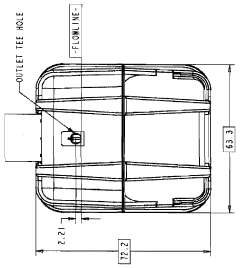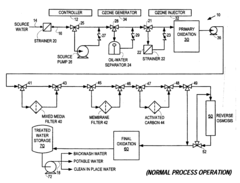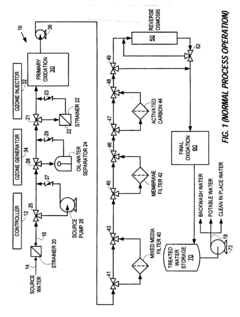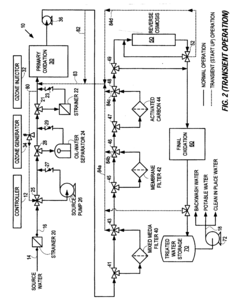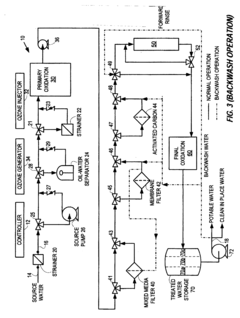Hastelloy's Application in Modern Water Treatment Facilities
JUL 10, 20258 MIN READ
Generate Your Research Report Instantly with AI Agent
Patsnap Eureka helps you evaluate technical feasibility & market potential.
Hastelloy Evolution
Hastelloy, a family of nickel-chromium-molybdenum superalloys, has undergone significant evolution since its inception in the 1920s. Initially developed by Haynes International, these alloys were designed to withstand extreme corrosion and high-temperature environments, making them ideal for use in chemical processing industries.
The evolution of Hastelloy began with the introduction of Hastelloy B, which was primarily composed of nickel and molybdenum. This alloy demonstrated exceptional resistance to hydrochloric acid and reducing environments. However, its limitations in oxidizing conditions led to the development of Hastelloy C in the 1930s, which incorporated chromium to enhance oxidation resistance.
As industrial demands grew more complex, particularly in the water treatment sector, Hastelloy continued to evolve. The 1960s saw the introduction of Hastelloy C-276, a landmark alloy that offered superior resistance to a wide range of chemical environments. This grade became a staple in water treatment facilities due to its ability to withstand chloride-induced stress corrosion cracking and pitting.
The 1980s marked another significant milestone with the development of Hastelloy C-22. This alloy further improved upon the corrosion resistance of its predecessors, particularly in oxidizing media. Its enhanced durability made it an excellent choice for components in desalination plants and wastewater treatment systems exposed to aggressive chemicals and high chloride concentrations.
In recent decades, the evolution of Hastelloy has focused on fine-tuning compositions to meet specific industry needs. Hastelloy C-2000, introduced in the 1990s, was designed with increased copper content to improve resistance to sulfuric acid, making it particularly useful in certain water treatment processes involving acidic conditions.
The latest advancements in Hastelloy technology have led to the development of grades like Hastelloy G-35 and Hastelloy G-30, which offer improved resistance to phosphoric acid and other specific corrosive media encountered in advanced water treatment applications. These newer alloys demonstrate the ongoing commitment to tailoring Hastelloy compositions to address evolving challenges in water treatment facilities.
Throughout its evolution, Hastelloy has consistently pushed the boundaries of material science, adapting to the increasing demands of modern water treatment technologies. From its early focus on general corrosion resistance to the development of specialized grades for specific applications, Hastelloy's journey reflects the growing sophistication of water treatment processes and the need for materials that can withstand increasingly harsh operating conditions.
The evolution of Hastelloy began with the introduction of Hastelloy B, which was primarily composed of nickel and molybdenum. This alloy demonstrated exceptional resistance to hydrochloric acid and reducing environments. However, its limitations in oxidizing conditions led to the development of Hastelloy C in the 1930s, which incorporated chromium to enhance oxidation resistance.
As industrial demands grew more complex, particularly in the water treatment sector, Hastelloy continued to evolve. The 1960s saw the introduction of Hastelloy C-276, a landmark alloy that offered superior resistance to a wide range of chemical environments. This grade became a staple in water treatment facilities due to its ability to withstand chloride-induced stress corrosion cracking and pitting.
The 1980s marked another significant milestone with the development of Hastelloy C-22. This alloy further improved upon the corrosion resistance of its predecessors, particularly in oxidizing media. Its enhanced durability made it an excellent choice for components in desalination plants and wastewater treatment systems exposed to aggressive chemicals and high chloride concentrations.
In recent decades, the evolution of Hastelloy has focused on fine-tuning compositions to meet specific industry needs. Hastelloy C-2000, introduced in the 1990s, was designed with increased copper content to improve resistance to sulfuric acid, making it particularly useful in certain water treatment processes involving acidic conditions.
The latest advancements in Hastelloy technology have led to the development of grades like Hastelloy G-35 and Hastelloy G-30, which offer improved resistance to phosphoric acid and other specific corrosive media encountered in advanced water treatment applications. These newer alloys demonstrate the ongoing commitment to tailoring Hastelloy compositions to address evolving challenges in water treatment facilities.
Throughout its evolution, Hastelloy has consistently pushed the boundaries of material science, adapting to the increasing demands of modern water treatment technologies. From its early focus on general corrosion resistance to the development of specialized grades for specific applications, Hastelloy's journey reflects the growing sophistication of water treatment processes and the need for materials that can withstand increasingly harsh operating conditions.
Water Treatment Demand
The global water treatment market has been experiencing significant growth, driven by increasing water scarcity, stricter environmental regulations, and growing awareness of water quality issues. This surge in demand has created a pressing need for advanced materials and technologies in water treatment facilities, particularly in corrosive environments where traditional materials fail to perform adequately.
Hastelloy, a family of nickel-chromium-molybdenum alloys, has emerged as a crucial material in modern water treatment facilities due to its exceptional corrosion resistance and durability. The demand for Hastelloy in this sector is primarily fueled by its ability to withstand harsh chemical environments, high temperatures, and extreme pH levels commonly encountered in water treatment processes.
In municipal water treatment plants, there is a growing need for materials that can handle increasingly complex water purification methods. As cities expand and water sources become more polluted, treatment facilities must employ more aggressive chemical treatments and advanced filtration systems. Hastelloy components, such as pumps, valves, and piping, are in high demand for their ability to resist corrosion from chlorine, chlorine dioxide, and other disinfectants used in these processes.
The industrial wastewater treatment sector also contributes significantly to the demand for Hastelloy. Industries such as chemical manufacturing, pharmaceuticals, and oil and gas produce highly corrosive effluents that require specialized treatment before discharge. Hastelloy's resistance to acids, alkalis, and organic compounds makes it an ideal material for constructing reactors, heat exchangers, and other critical components in these challenging environments.
Desalination plants represent another major market for Hastelloy applications. As freshwater sources become scarce in many regions, the need for seawater desalination has increased dramatically. The highly corrosive nature of seawater, combined with the high-pressure and high-temperature conditions in desalination processes, necessitates the use of materials like Hastelloy to ensure long-term reliability and efficiency of the treatment systems.
The growing focus on water reuse and recycling in both industrial and municipal settings has further boosted the demand for Hastelloy. Advanced treatment technologies such as membrane filtration, UV disinfection, and electrochemical processes often involve corrosive chemicals and challenging operating conditions, making Hastelloy an attractive material choice for system components.
As water treatment facilities increasingly adopt automation and smart technologies, the reliability of equipment becomes even more critical. Hastelloy's durability and resistance to corrosion-induced failures align well with the industry's push towards minimizing downtime and maintenance costs, further driving its demand in modern water treatment applications.
Hastelloy, a family of nickel-chromium-molybdenum alloys, has emerged as a crucial material in modern water treatment facilities due to its exceptional corrosion resistance and durability. The demand for Hastelloy in this sector is primarily fueled by its ability to withstand harsh chemical environments, high temperatures, and extreme pH levels commonly encountered in water treatment processes.
In municipal water treatment plants, there is a growing need for materials that can handle increasingly complex water purification methods. As cities expand and water sources become more polluted, treatment facilities must employ more aggressive chemical treatments and advanced filtration systems. Hastelloy components, such as pumps, valves, and piping, are in high demand for their ability to resist corrosion from chlorine, chlorine dioxide, and other disinfectants used in these processes.
The industrial wastewater treatment sector also contributes significantly to the demand for Hastelloy. Industries such as chemical manufacturing, pharmaceuticals, and oil and gas produce highly corrosive effluents that require specialized treatment before discharge. Hastelloy's resistance to acids, alkalis, and organic compounds makes it an ideal material for constructing reactors, heat exchangers, and other critical components in these challenging environments.
Desalination plants represent another major market for Hastelloy applications. As freshwater sources become scarce in many regions, the need for seawater desalination has increased dramatically. The highly corrosive nature of seawater, combined with the high-pressure and high-temperature conditions in desalination processes, necessitates the use of materials like Hastelloy to ensure long-term reliability and efficiency of the treatment systems.
The growing focus on water reuse and recycling in both industrial and municipal settings has further boosted the demand for Hastelloy. Advanced treatment technologies such as membrane filtration, UV disinfection, and electrochemical processes often involve corrosive chemicals and challenging operating conditions, making Hastelloy an attractive material choice for system components.
As water treatment facilities increasingly adopt automation and smart technologies, the reliability of equipment becomes even more critical. Hastelloy's durability and resistance to corrosion-induced failures align well with the industry's push towards minimizing downtime and maintenance costs, further driving its demand in modern water treatment applications.
Hastelloy Challenges
Despite its remarkable properties, Hastelloy faces several challenges in its application to modern water treatment facilities. One of the primary concerns is the high initial cost of Hastelloy components compared to more conventional materials. This cost factor often leads to hesitation among facility managers when considering Hastelloy for large-scale implementations, particularly in budget-constrained projects.
Another significant challenge is the complexity of fabrication and welding processes for Hastelloy. The material's unique composition requires specialized welding techniques and equipment, which can increase manufacturing time and costs. Additionally, the need for skilled technicians with experience in working with Hastelloy can pose difficulties in certain regions where such expertise may be limited.
The long-term performance of Hastelloy in diverse water treatment environments remains an area of ongoing research. While the alloy demonstrates excellent corrosion resistance in many scenarios, its behavior under extreme conditions or in the presence of certain chemical combinations is not fully understood. This uncertainty can lead to conservative design approaches, potentially limiting the full utilization of Hastelloy's capabilities.
Maintenance and repair of Hastelloy components present another set of challenges. The material's hardness and resistance to corrosion, while beneficial in operation, can make repairs and modifications more difficult and time-consuming. This aspect needs to be carefully considered in the lifecycle planning of water treatment facilities.
Environmental concerns related to the mining and processing of the rare elements used in Hastelloy production have also emerged as a challenge. As sustainability becomes increasingly important in industrial practices, the environmental footprint of Hastelloy production and its long-term ecological impact are subjects of scrutiny.
The integration of Hastelloy components with other materials in water treatment systems can sometimes lead to galvanic corrosion issues. Careful design and material selection are necessary to mitigate these risks, adding another layer of complexity to engineering processes.
Lastly, the regulatory landscape surrounding the use of advanced materials like Hastelloy in water treatment facilities is still evolving. Compliance with varying international standards and obtaining necessary certifications can be a time-consuming and complex process, potentially slowing down the adoption of Hastelloy in certain markets or applications.
Another significant challenge is the complexity of fabrication and welding processes for Hastelloy. The material's unique composition requires specialized welding techniques and equipment, which can increase manufacturing time and costs. Additionally, the need for skilled technicians with experience in working with Hastelloy can pose difficulties in certain regions where such expertise may be limited.
The long-term performance of Hastelloy in diverse water treatment environments remains an area of ongoing research. While the alloy demonstrates excellent corrosion resistance in many scenarios, its behavior under extreme conditions or in the presence of certain chemical combinations is not fully understood. This uncertainty can lead to conservative design approaches, potentially limiting the full utilization of Hastelloy's capabilities.
Maintenance and repair of Hastelloy components present another set of challenges. The material's hardness and resistance to corrosion, while beneficial in operation, can make repairs and modifications more difficult and time-consuming. This aspect needs to be carefully considered in the lifecycle planning of water treatment facilities.
Environmental concerns related to the mining and processing of the rare elements used in Hastelloy production have also emerged as a challenge. As sustainability becomes increasingly important in industrial practices, the environmental footprint of Hastelloy production and its long-term ecological impact are subjects of scrutiny.
The integration of Hastelloy components with other materials in water treatment systems can sometimes lead to galvanic corrosion issues. Careful design and material selection are necessary to mitigate these risks, adding another layer of complexity to engineering processes.
Lastly, the regulatory landscape surrounding the use of advanced materials like Hastelloy in water treatment facilities is still evolving. Compliance with varying international standards and obtaining necessary certifications can be a time-consuming and complex process, potentially slowing down the adoption of Hastelloy in certain markets or applications.
Current Applications
01 Composition and properties of Hastelloy alloys
Hastelloy is a family of nickel-based superalloys known for their excellent corrosion resistance and high-temperature strength. These alloys typically contain varying amounts of chromium, molybdenum, and other elements to enhance their performance in harsh environments. The specific composition and properties can be tailored for different applications, such as chemical processing, aerospace, and nuclear industries.- Composition and properties of Hastelloy alloys: Hastelloy is a family of nickel-based superalloys known for their excellent corrosion resistance and high-temperature strength. These alloys typically contain varying amounts of chromium, molybdenum, and other elements to enhance their performance in harsh environments. The specific composition and properties can be tailored for different applications, such as chemical processing, aerospace, and nuclear industries.
- Manufacturing processes for Hastelloy components: Various manufacturing processes are employed to produce Hastelloy components, including casting, forging, and powder metallurgy techniques. Advanced manufacturing methods, such as additive manufacturing or 3D printing, are also being explored to create complex Hastelloy parts with improved performance characteristics. Heat treatment processes are often used to optimize the microstructure and properties of the final products.
- Applications of Hastelloy in corrosive environments: Hastelloy alloys are widely used in industries where corrosion resistance is critical. They are particularly suitable for applications involving aggressive chemicals, high temperatures, and pressure. Common uses include heat exchangers, chemical reactors, piping systems, and components in offshore oil and gas production. The alloys' resistance to pitting, crevice corrosion, and stress corrosion cracking makes them valuable in these challenging environments.
- Welding and joining techniques for Hastelloy: Specialized welding and joining techniques are required for Hastelloy components due to their unique properties. These may include gas tungsten arc welding (GTAW), gas metal arc welding (GMAW), and electron beam welding. Proper selection of filler materials, pre-heating, and post-weld heat treatment are crucial to maintain the alloy's corrosion resistance and mechanical properties in the welded areas.
- Surface treatment and coating of Hastelloy: Various surface treatment and coating techniques are applied to Hastelloy components to further enhance their performance or provide additional functionality. These may include electroplating, thermal spraying, or the application of specialized coatings. Such treatments can improve wear resistance, reduce friction, or provide additional corrosion protection in specific environments.
02 Manufacturing processes for Hastelloy components
Various manufacturing processes are employed to produce Hastelloy components, including casting, forging, and powder metallurgy techniques. Advanced manufacturing methods such as additive manufacturing and precision machining are also used to create complex Hastelloy parts. Heat treatment processes are often applied to optimize the microstructure and properties of the final products.Expand Specific Solutions03 Applications of Hastelloy in corrosive environments
Hastelloy alloys are widely used in highly corrosive environments due to their exceptional resistance to various forms of corrosion, including pitting, crevice corrosion, and stress corrosion cracking. They are commonly employed in chemical processing equipment, heat exchangers, and components for the oil and gas industry. The alloys' ability to withstand aggressive media makes them suitable for use in acidic, alkaline, and chloride-containing environments.Expand Specific Solutions04 High-temperature applications of Hastelloy
Hastelloy alloys exhibit excellent mechanical properties and oxidation resistance at elevated temperatures, making them suitable for high-temperature applications. They are used in gas turbine components, furnace equipment, and other high-temperature industrial processes. The alloys maintain their strength and corrosion resistance at temperatures well above those tolerated by conventional stainless steels.Expand Specific Solutions05 Welding and joining techniques for Hastelloy
Specialized welding and joining techniques are employed for Hastelloy components to maintain their corrosion resistance and mechanical properties. These include gas tungsten arc welding (GTAW), gas metal arc welding (GMAW), and electron beam welding. Proper selection of filler materials and post-weld heat treatments are crucial to ensure the integrity of the welded joints and prevent sensitization or other detrimental effects on the alloy's performance.Expand Specific Solutions
Key Hastelloy Producers
The application of Hastelloy in modern water treatment facilities represents a mature technology in a growing market. The industry is in a consolidation phase, with established players like Evoqua Water Technologies LLC and Culligan International Co. dominating the field. The global water treatment market is expanding, driven by increasing water scarcity and stricter environmental regulations. Technologically, Hastelloy's corrosion resistance makes it ideal for harsh water treatment environments. Research institutions like the Council of Scientific & Industrial Research and universities such as Harbin Institute of Technology continue to innovate in this space, while companies like Baxter International, Inc. and Siemens Industry, Inc. integrate Hastelloy into their advanced water treatment solutions.
Evoqua Water Technologies LLC
Technical Solution: Evoqua Water Technologies LLC has developed advanced Hastelloy-based solutions for modern water treatment facilities. Their approach involves using Hastelloy C-276 in critical components of their water treatment systems, particularly in high-corrosion environments. The company has implemented Hastelloy-lined reactors and heat exchangers in their chlorine dioxide generation systems, which are crucial for disinfection in water treatment[1]. Additionally, Evoqua has integrated Hastelloy into their electrochlorination cells, enhancing the durability and efficiency of their seawater treatment processes[2]. The company's innovative use of Hastelloy extends to their membrane filtration systems, where Hastelloy components are used in high-pressure, high-salinity applications, significantly improving system longevity and performance in challenging water conditions[3].
Strengths: Superior corrosion resistance in aggressive environments, extended equipment lifespan, reduced maintenance costs. Weaknesses: Higher initial investment, limited availability of Hastelloy components compared to more common materials.
Hitachi Plant Technologies Ltd.
Technical Solution: Hitachi Plant Technologies Ltd. has pioneered the application of Hastelloy in modern water treatment facilities, particularly in seawater desalination and industrial wastewater treatment. Their approach involves using Hastelloy C-276 and C-22 in critical components of their multi-stage flash (MSF) and reverse osmosis (RO) desalination systems. Hitachi has developed proprietary Hastelloy-clad heat exchangers for their MSF units, significantly improving corrosion resistance and thermal efficiency in high-temperature, high-salinity environments[10]. In their RO systems, Hitachi utilizes Hastelloy in high-pressure pump components and energy recovery devices, enhancing system durability and energy efficiency[11]. The company has also implemented Hastelloy in their advanced oxidation process (AOP) reactors for industrial wastewater treatment, particularly in applications involving aggressive chemicals and high temperatures. Additionally, Hitachi has developed a novel Hastelloy-based membrane support system for their ultrafiltration modules, improving membrane integrity and longevity in challenging water conditions[12].
Strengths: Exceptional performance in high-temperature, high-salinity environments, improved energy efficiency in desalination processes, enhanced durability in industrial wastewater treatment. Weaknesses: High material costs, potential limitations in sourcing specialized Hastelloy components.
Hastelloy Innovations
Water treatment apparatus and clarifier wall
PatentWO2008070696A1
Innovation
- A water treatment plant design featuring a polymeric tank formed from multiple sections with a hanging clarifier baffle that incorporates angled portions at the bottom, allowing for increased settling chamber volume and improved solid removal efficiency by redirecting water flow effectively between the treatment and settling chambers.
Water treatment systems and methods
PatentInactiveUS20130313191A1
Innovation
- A self-contained, portable water treatment system with multiple treatment subsystems, including strainers, ozone injectors, filtration systems, and sensors, controlled by a controller that automatically selects treatment processes based on water quality parameters, allowing for efficient contaminant removal and energy conservation.
Environmental Impact
The application of Hastelloy in modern water treatment facilities has significant environmental implications, both positive and negative. On the positive side, Hastelloy's exceptional corrosion resistance and durability contribute to the longevity of water treatment equipment, reducing the need for frequent replacements and minimizing waste generation. This extended lifespan translates to fewer resources consumed in manufacturing and transportation of replacement parts, thereby lowering the overall carbon footprint of water treatment operations.
Furthermore, Hastelloy's resistance to a wide range of chemicals allows for more efficient and effective water treatment processes. This capability enables the removal of a broader spectrum of contaminants, including emerging pollutants, leading to cleaner water output and reduced environmental impact downstream. The material's ability to withstand harsh conditions also permits the use of more aggressive treatment methods, potentially reducing the reliance on chemical additives and minimizing the introduction of secondary pollutants into the environment.
However, the environmental impact of Hastelloy production must be considered. The mining and processing of nickel, chromium, and molybdenum – key components of Hastelloy alloys – can have substantial environmental consequences, including habitat disruption, energy consumption, and greenhouse gas emissions. The high-temperature manufacturing processes required for Hastelloy production also contribute to its environmental footprint.
In terms of end-of-life considerations, while Hastelloy components have a long service life, their eventual disposal or recycling presents challenges. The complex alloy composition can make recycling more difficult compared to simpler metals, potentially leading to increased landfill waste if proper recycling infrastructure is not in place.
Despite these concerns, the net environmental impact of Hastelloy in water treatment facilities is generally positive when considering the long-term benefits. The material's contribution to more efficient water purification processes and reduced maintenance requirements often outweighs the initial environmental costs of production. As water scarcity and pollution become increasingly pressing global issues, the role of advanced materials like Hastelloy in ensuring sustainable water treatment solutions becomes ever more critical.
Furthermore, Hastelloy's resistance to a wide range of chemicals allows for more efficient and effective water treatment processes. This capability enables the removal of a broader spectrum of contaminants, including emerging pollutants, leading to cleaner water output and reduced environmental impact downstream. The material's ability to withstand harsh conditions also permits the use of more aggressive treatment methods, potentially reducing the reliance on chemical additives and minimizing the introduction of secondary pollutants into the environment.
However, the environmental impact of Hastelloy production must be considered. The mining and processing of nickel, chromium, and molybdenum – key components of Hastelloy alloys – can have substantial environmental consequences, including habitat disruption, energy consumption, and greenhouse gas emissions. The high-temperature manufacturing processes required for Hastelloy production also contribute to its environmental footprint.
In terms of end-of-life considerations, while Hastelloy components have a long service life, their eventual disposal or recycling presents challenges. The complex alloy composition can make recycling more difficult compared to simpler metals, potentially leading to increased landfill waste if proper recycling infrastructure is not in place.
Despite these concerns, the net environmental impact of Hastelloy in water treatment facilities is generally positive when considering the long-term benefits. The material's contribution to more efficient water purification processes and reduced maintenance requirements often outweighs the initial environmental costs of production. As water scarcity and pollution become increasingly pressing global issues, the role of advanced materials like Hastelloy in ensuring sustainable water treatment solutions becomes ever more critical.
Cost-Benefit Analysis
The implementation of Hastelloy in modern water treatment facilities presents a complex cost-benefit scenario that requires careful analysis. Initially, the high cost of Hastelloy materials may seem prohibitive, with prices significantly exceeding those of standard stainless steel alternatives. However, the long-term benefits often outweigh the upfront expenses.
Hastelloy's superior corrosion resistance translates to extended equipment lifespan, reducing the frequency of replacements and associated downtime. This durability is particularly valuable in aggressive water treatment environments, where chemical exposure and high temperatures are common. The reduction in maintenance and replacement costs over time can lead to substantial savings, often surpassing the initial investment within a few years of operation.
Furthermore, Hastelloy's resistance to pitting and crevice corrosion minimizes the risk of equipment failure, which could result in costly production interruptions or environmental incidents. This enhanced reliability contributes to improved operational efficiency and reduced risk management costs.
The material's excellent performance in high-temperature and high-pressure conditions allows for more efficient water treatment processes. This can lead to increased throughput and potentially lower energy consumption, further improving the cost-effectiveness of operations.
However, the cost-benefit analysis must also consider factors such as the specific water treatment application, local regulations, and the facility's operational lifespan. In some cases, the benefits may not justify the higher initial costs, particularly for smaller-scale operations or those with less demanding environments.
It's crucial to conduct a thorough lifecycle cost analysis, factoring in initial procurement, installation, operational efficiency, maintenance requirements, and end-of-life considerations. This comprehensive approach provides a more accurate picture of the true cost-benefit ratio of implementing Hastelloy in water treatment facilities.
Additionally, the potential for improved product quality and compliance with stringent environmental regulations should be quantified when possible. These factors can have significant indirect financial impacts, influencing the overall cost-benefit assessment.
In conclusion, while the upfront costs of Hastelloy implementation are substantial, the long-term benefits in terms of durability, reliability, and operational efficiency often result in a favorable cost-benefit ratio for modern water treatment facilities, particularly those operating in challenging conditions or with extended operational timelines.
Hastelloy's superior corrosion resistance translates to extended equipment lifespan, reducing the frequency of replacements and associated downtime. This durability is particularly valuable in aggressive water treatment environments, where chemical exposure and high temperatures are common. The reduction in maintenance and replacement costs over time can lead to substantial savings, often surpassing the initial investment within a few years of operation.
Furthermore, Hastelloy's resistance to pitting and crevice corrosion minimizes the risk of equipment failure, which could result in costly production interruptions or environmental incidents. This enhanced reliability contributes to improved operational efficiency and reduced risk management costs.
The material's excellent performance in high-temperature and high-pressure conditions allows for more efficient water treatment processes. This can lead to increased throughput and potentially lower energy consumption, further improving the cost-effectiveness of operations.
However, the cost-benefit analysis must also consider factors such as the specific water treatment application, local regulations, and the facility's operational lifespan. In some cases, the benefits may not justify the higher initial costs, particularly for smaller-scale operations or those with less demanding environments.
It's crucial to conduct a thorough lifecycle cost analysis, factoring in initial procurement, installation, operational efficiency, maintenance requirements, and end-of-life considerations. This comprehensive approach provides a more accurate picture of the true cost-benefit ratio of implementing Hastelloy in water treatment facilities.
Additionally, the potential for improved product quality and compliance with stringent environmental regulations should be quantified when possible. These factors can have significant indirect financial impacts, influencing the overall cost-benefit assessment.
In conclusion, while the upfront costs of Hastelloy implementation are substantial, the long-term benefits in terms of durability, reliability, and operational efficiency often result in a favorable cost-benefit ratio for modern water treatment facilities, particularly those operating in challenging conditions or with extended operational timelines.
Unlock deeper insights with Patsnap Eureka Quick Research — get a full tech report to explore trends and direct your research. Try now!
Generate Your Research Report Instantly with AI Agent
Supercharge your innovation with Patsnap Eureka AI Agent Platform!


